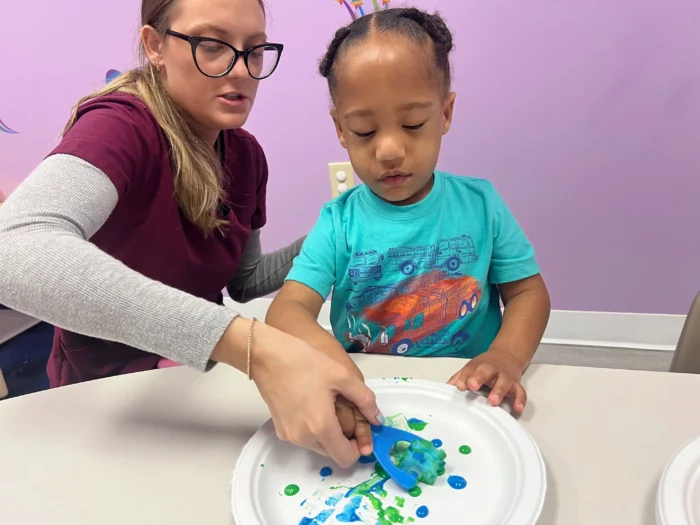
As awareness of developmental conditions grows, the focus on Down syndrome and autism highlights the real challenges of families dealing with these diagnoses. While both conditions are distinct, understanding the difference between autism vs Down syndrome is crucial for adjusting the therapy to the child’s needs.
This article will provide you with clear insights into both conditions, explaining how they differ and overlap—and how to recognize the signs of each.
Understanding Autism
Autism Spectrum Disorder (ASD), commonly referred to as autism, is a complex developmental condition. Unlike Down syndrome, which has a clear genetic cause, the origins of autism are not fully understood and are thought to involve a combination of genetic and environmental factors.
Children with autism may show signs early in life, often before the age of two. Some of these signs include:
- Delayed speech and language skills
- Difficulty making eye contact
- Limited interest in peer relationships
- Engaging in repetitive movements
Each child with autism is unique, with symptoms ranging from mild to severe, and they may require different levels of support.
Early intervention plays a critical role in helping children with autism develop to their full potential. Language therapy, occupational therapy, and behavioral interventions can significantly improve their quality of life.
Decoding Down Syndrome
Down syndrome is a genetic disorder caused by the presence of an extra copy of chromosome 21, also known as trisomy 21. Unlike autism, where the signs can vary widely among individuals, Down syndrome is characterized by more consistent physical traits and cognitive impairments.
Individuals with Down syndrome may have a flat facial profile, almond-shaped eyes that slant upwards, short neck, and small hands and feet. Beyond physical characteristics, they often experience mild to moderate intellectual disability, which affects learning and cognitive development differently than autism does.
With supportive educational programs, therapies, and interventions, many individuals with Down syndrome can lead fulfilling lives, engaging in educational, social, and vocational activities.
Exploring the Differences and Similarities
Understanding how autism and Down syndrome differ and intersect is key to providing the right support for those affected. While both are developmental conditions, their origins, manifestations, and impacts on individuals vary significantly.
Difference Between Autism and Down Syndrome
Navigating the differences between autism spectrum and Down syndrome can often feel overwhelming.
Below, we’ve detailed a side-by-side comparison, focusing on key aspects like their causes, common symptoms, and diagnosis.
| Aspect | Autism | Down Syndrome |
| Origin | A neurodevelopmental condition without a single known cause, influenced by genetic and environmental factors | A genetic disorder caused by an extra copy of chromosome 21 |
| Most Common Symptoms |
|
|
| Diagnosis | Through behavioral observations and developmental screenings, often evident in early childhood but can be subtle | Can be diagnosed prenatally or shortly after birth through genetic testing due to clear chromosomal indicators |
Similarities Between Autism and Down Syndrome
While autism spectrum and Down syndrome are distinct conditions, both groups of individuals may face difficulties with communication, such as articulating thoughts or interpreting emotions, which impacts their ability to build and maintain relationships. Challenges in understanding social nuances, like taking turns in conversation or reading facial expressions, are also common.
Despite these challenges, people with either autism or Down syndrome possess a diverse range of skills and potential, some of them more notable than the others. For instance, a child with Down syndrome may excel in visual learning, while a child with autism might have excellent memory.
Early and customized support is crucial for both conditions. This includes speech therapy to overcome communication hurdles and social skills groups to improve interaction abilities. Such targeted interventions are tailored to their specific needs, encouraging development and enhancing quality of life.
Recognizing the Signs of Autism in Down Syndrome
The signs of autism can sometimes mirror or amplify the communication and behavioral challenges commonly associated with Down syndrome alone. These signs may include:
- Increased difficulty with social interactions beyond what is typically observed in Down syndrome
- Repetitive behaviors and routines that are more pronounced or rigid
- Challenges in adapting to changes in routine or environment, which may lead to increased distress
- Limited interest in social play, even with familiar individuals, differing from the expected level of social engagement in Down syndrome
When a child is diagnosed with both Down syndrome and autism, families may face a unique set of challenges that require a careful and personalized plan for intervention and support. At Abacus Therapies, we can help you with custom ABA therapy sessions created for your individual situation.
Down Syndrome and Autism Life Expectancy
Many parents and caregivers worry about what the future holds, especially when it comes to the life expectancy of loved ones with Down syndrome or autism. While Down syndrome itself may come with health challenges that can affect lifespan, such as heart conditions and increased susceptibility to certain infections, the addition of autism does not necessarily decrease life expectancy.
Also, the life expectancy of individuals with Down syndrome has significantly increased over the years due to medical advancements and improved access to health care. Thanks to this, the average life expectancy of a person with Down syndrome today stands at almost 60 years, which is amazing compared to 1983, when that number was much lower, at just 25 years of age.
Life expectancy for individuals with autism has also improved with advances in healthcare and understanding. Today, autistic men and women without learning disabilities can live, on average, 74.6 and 76.8 years, respectively.
A proactive approach to health, emphasizing preventive care, regular check-ups, and timely intervention for medical issues, can help them live a longer and more comfortable life.
Crafting Supportive Environments for Both Conditions
Creating an environment that caters to the needs of individuals with autism and Down syndrome, involves:
- Personalized Therapeutic Interventions: Engaging in therapies that address the unique combination of needs, such as ABA therapy.
- Educational Support: Developing educational plans that consider both the learning styles associated with autism and the cognitive profile of Down syndrome.
- Family and Community Support: Leveraging support from families, communities, and specialized organizations to build a network of care and understanding.
Conclusion
While autism and Down syndrome are distinct diagnoses, it’s important for parents to understand both, especially considering the possibility of a dual diagnosis. This knowledge enables parents to better advocate for their children and navigate the challenges and opportunities of raising a child with developmental differences.
If you have any questions about the two or how ABA therapy can help children with Down syndrome who are also on the spectrum, feel free to reach out to our team. We’ve been providing ABA services and consulting since 2017 and we believe in custom ABA therapy.
Our teams of dedicated ABA therapists are operating in South Florida on three locations. Abacus Therapies is also providing ABA sessions in North Carolina (Charlotte), and Georgia (Atlanta). We’ll be happy to meet you via email, text, and call, and answer all your queries!
FAQs
Are Down syndrome and autism related?
Down syndrome and autism are separate and distinct conditions with their own causes and characteristics. However, they can co-occur in the same individual, a situation known as a dual diagnosis.
What syndrome is mistaken for autism?
Conditions such as Fragile X syndrome, Rett syndrome, and Williams syndrome are sometimes mistaken for autism due to overlapping symptoms, especially in early childhood. These common features include difficulties with social interactions and communication, but each of the conditions has distinct causes and developmental patterns.
Which is worse: autism or Down syndrome?
Both autism and Down syndrome come with their own sets of challenges and strengths, and the impact of each condition differs among individuals. The severity, available support, and specific circumstances of each person determine their experience.
Is there a Down syndrome spectrum?
Down syndrome is not considered a spectrum disorder but a genetic condition caused by the presence of an extra third copy of chromosome 21. However, the manifestation of Down syndrome can vary among individuals, affecting physical development, cognitive abilities, and health in diverse ways.



